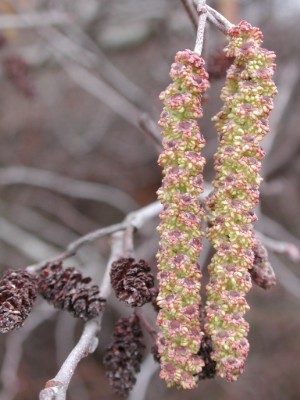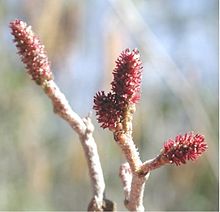Alnus
| Alders | |
|---|---|
 | |
| Genus: | Alnus |
| Family: | Betulaceae |
| Pollination: | Wind |
Alders (Alnus) are trees and shrubs in the birch family (Family Betulaceae). The genus comprises about 20-30 species of monoecious trees and shrubs, few reaching large size, distributed throughout the North Temperate zone, and in the New World also along the Andes southwards to Chile. The common name alder is derived from an old Germanic root. The botanic name Alnus is the original Latin name.
The best-known species in Europe is the Common or Black Alder (A. glutinosa), native to most of Europe and widely introduced elsewhere. The largest species is Red Alder (A. rubra), reaching 35 m (the tallest is 32 m) on the west coast of North America, with Black Alder and Italian Alder (A. cordata) both reaching about 30 m. By contrast, the widespread Green Alder (A. viridis) is rarely more than a 5 m shrub.
Description
[edit | edit source]The leaves are deciduous, alternate, simple, with serrated margins and pinnate veination. Trunks of most species corded, stems thin, flexible, and triangular in cross-section.
The flowers are catkins with elongate male catkins on the same plant as the shorter female catkins, often before leaves appear; they are mainly wind-pollinated, but also visited by bees as a pollen source. They differ from the birches (Betula, the other genus in the family) in that the female catkins are woody and do not disintegrate at maturity, opening to release the seeds in a similar manner to many conifer cones. The "cones" are persistent.
Seeds are small winged samaras.
Growing Conditions
[edit | edit source]Sun to shade, adapted to poor soils, and most species do well in wet soils.
Species
[edit | edit source]The genus is divided into three subgenera:
Subgenus Alnus. Trees. Shoot buds stalked. Male and female catkins produced in autumn (fall) but staying closed over winter, pollinating in late winter or early spring. About 15-25 species, including:
- Alnus acuminata - Andean Alder. Andes Mountains, South America.
- Alnus cordata - Italian Alder. Italy.
- Alnus cremastogyne
- Alnus glutinosa - Black Alder. Europe.
- Alnus incana - Grey Alder. Europe & Asia.
- Alnus oblongifolia (A. incana subsp. oblongifolia) - Arizona Alder. Southwestern North America.
- Alnus rugosa (A. incana subsp. rugosa) - Speckled Alder. Northeastern North America.
- Alnus tenuifolia (A. incana subsp. tenuifolia) - Thinleaf Alder or Mountain Alder. Northwestern North America.
- Alnus japonica - Japanese Alder. Japan.
- Alnus jorullensis - Mexican Alder. Mexico, Guatemala.
- Alnus nepalensis - Nepalese Alder. Eastern Himalaya, southwest China.
- Alnus orientalis - Oriental Alder. Southern Turkey, northwest Syria, Cyprus.
- Alnus rhombifolia - White Alder. Interior western North America.
- Alnus rubra - Red Alder. West coastal North America.
- Alnus serrulata - Hazel alder, Tag Alder or Smooth alder. Eastern North America.
- Alnus subcordata - Caucasian Alder. Caucasus, Iran.
Subgenus Clethropsis. Trees or shrubs. Shoot buds stalked. Male and female catkins produced in autumn (fall) and expanding and pollinating then. Three species:
- Alnus formosana -Formosan Alder Taiwan
- Alnus maritima - Seaside Alder. East coastal North America, plus disjunct population in Oklahoma.
- Alnus nitida - Himalayan Alder. Western Himalaya.

Subgenus Alnobetula. Shrubs. Shoot buds not stalked. Male and female catkins produced in late spring (after leaves appear) and expanding and pollinating then. One to four species:
- Alnus viridis - Green Alder. Widespread:
- Alnus viridis subsp. viridis. Eurasia.
- Alnus viridis subsp. maximowiczii (A. maximowiczii). Japan.
- Alnus viridis subsp. crispa (A. crispa). Northern North America.
- Alnus viridis subsp. sinuata (A. sinuata, Sitka Alder or Slide Alder). Western North America, far northeastern Siberia.
Uses
[edit | edit source]
Alders establish symbioses with the nitrogen-fixing Actinobacteria Frankiella alni. This bacteria converts atmospheric nitrogen into soil-soluble nitrates which can be utilised by the alder, and favorably enhances the soil fertility generally. Alders benefit other plants growing near them by taking nitrogen out of the air and depositing it in the soil in usable form; fallen alder leaves make very rich compost. Alders are sturdy and fast-growing, even in acidic and damaged sites such as burned areas and mining sites. Italian Alder is particularly useful on dry, infertile sites. Alders can be used as a producer of simple bio-mass, growing quickly in harsh environments.
Alder catkins are one of the earliest available sources of pollen for bee species in the spring, especially honeybees, which use it for spring buildup.
Alders are grown for their bark, form, and for the catkins, which are used in dry floral arrangements. Alders can also be grown as bonsai.
Alder is a preferred wood for charcoal making, formerly used in the manufacture of gunpowder, or for smelting metal ores, now used primarily for cooking. The wood is also traditionally used for smoking fish and meat, though this usage has often been replaced by other woods such as oak and hickory. It is popular as a material for electric guitar bodies, and is used by many guitar makers, notably the Fender Guitar Company, who use it on top quality instruments such as the Stratocaster and Jaguar. Alder provides a brighter tone than other woods (such as mahogany), and as it is not a particularly dense wood it provides a resonant, well-rounded tone with excellent sustain.
Maintenance
[edit | edit source]Alders can be pruned either to encourage a tree-like habit, or coppiced as a dense shrub.
Propagation
[edit | edit source]By cuttings and seed, but cultivars may be budded or grafted.
Seed is collected in autumn as the catkins open, then cold-stratified for spring germination.
Pests and Diseases
[edit | edit source]- Erysiphe aggregata
- Microsphaera alni
- Phyllactinia corylea
- Taphrina macrophylla
Flower Distortions (Galls)
- Taphrina amentorium
- Taphrina occidentalis
- Taphrina robinsoniana
Canker (branch dieback)
- Nectria coccinea
- Physalospora obtusa
- Solenia anomala
Canker (trunk)
- Diatrypella oregonensis
- Didymosphaeria oregonensis
- Hymenochaete agglutinants
- Melampsporidium hiratsukanum (Aecial stage on Alnus)
- Phytophthora spp.
- Wooly Alder Aphid: Prociphilus tessellatus
- Buckeye Scale: Diaspidiotus aesculi
- Alder Psyllid: Psylla floccosa nymphs produce cottony wax
- Alder Lace Bug: Corythucha pergandei
- Alder Spittlebug: Clastoptera obtusa
- Alder Flea Beetle: Altica ambiens
- Alder Borer: Saperda obliqua
- Apple Flea Weevil: Rhynchaenus pallicarnis (leafminer)
- Elm Calligrapha (linden Leaf Beetle): Calligrapha scalaris
- Pacific Willow Leaf Beetle: Pyrrhalta decora carbo
- Birch Skeletonizer: Bucculatrix canadensisella
- Boxelder Leafroller: Archips negundamus
- Cecropia Moth: Hyalophora cecropia
- Eastern Tent Caterpillar: Malacosoma americanum
- Oak Clearwing Borer: Paranthene asilipennis
- Pale Tussock Moth: Halisidota tesselaris
- Spearmarked Black Moth: Rheumaptera hastata
- Threelined Leafroller: Pandemis limitata
- see w:list of Lepidoptera which feed on Alders.
- Birch Sawfly: Arge pectoralis
- European Alder Leafminer: Fenusa dohrnii
- Pouchgall Mite: Phytoptus laevis
References
[edit | edit source]- Chen, Zhiduan and Li, Jianhua (2004). Phylogenetics and Biogeography of Alnus (Betulaceae) Inferred from Sequences of Nuclear Ribosomal DNA ITS Region. International Journal of Plant Sciences 165: 325–335.
- Flora Europaea: Alnus
- Flora of Bolivia: Alnus
- Flora of China: Alnus
- Flora of North America: Alnus
- Flora of Pakistan: Alnus
- Britton, Nathaniel Lord (1913). An Illustrated Flora of the Northern United States and Canada, Volume 1 (second edition ed.). Dover Publications, inc. pp. 612–614.
{{cite book}}:|edition=has extra text (help); Unknown parameter|coauthors=ignored (|author=suggested) (help) - Ann Fowler Rhoads and Timothy A. Block (2000). The Plants of Pennsylvania: An Illustrated Manual. Anna Anisko, illustrator. Morris Arboretum, University of Pennsylvania Press. pp. 256–258.
{{cite book}}: Missing pipe in:|authorlink=(help) - P. D. Strausbaugh and Earl L. Core (1977). Flora of West Virginia (Second ed.). Seneca Books, Grantsville, W. Virginia. pp. 296–298.
{{cite book}}: Missing pipe in:|authorlink=(help) - Christopher Brickell and Judith D. Zuk (1997). The American Horticultural Society A-Z Encyclopedia of Garden Plants. DK Publishing. pp. 89–99.
{{cite book}}: Missing pipe in:|authorlink=(help) - Staff of the L. H. Bailey Hortorium (1976). Hortus Third: A Concise Dictionary of Plants Cultivated in the United States and Canada. Cornell University Press. pp. 55–56.
{{cite book}}: Missing pipe in:|authorlink=(help) - Pirone, Pascal P. (1978). Diseases & Pests of Ornamental Plants (Fifth Edition ed.). John Wiley & Sons, New York. pp. 125–126.
{{cite book}}:|edition=has extra text (help); Missing pipe in:|authorlink=(help) - Cranshaw, Whitney (2004). Garden Insects of North America: The Ultimate Guide to Backyard Bugs. Princeton University Press. p. 579.
{{cite book}}: Missing pipe in:|authorlink=(help)